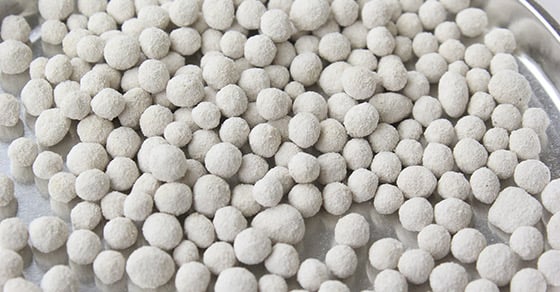Alumina, or Aluminum Oxide (Al2O3) is a chemical compound primarily known for its use in the production of aluminum – a metal slated for significant growth in the advance toward a low-carbon economy.
Prices of alumina have soared by 56%[1] on the back of shutdowns in China, with experts predicting the high purity alumina market will see a 16.7% [2] CAGR between 2016-2022.
But alumina does much more than serve as the primary constituent of aluminum; with its valuable combination of characteristics, alumina is employed in many other applications as well.
Characteristics of Alumina
Alumina presents a number of characteristics that not only make it ideal for aluminum, but also valuable in a wide range of other applications:
- High thermal conductivity
- High hardness
- Resistance to abrasion
- Resistance to many forms of chemical attack
- Corrosion resistance (alumina is what lends corrosion resistance to aluminum metals)
- Wear resistance
- Electrically and thermally insulating
- And more…
Uses of Alumina
The superior characteristics alumina can offer make it ideal for use in many applications. Some of the most common applications outside of aluminum production are listed below.
Abrasives
Alumina is widely used in a variety of industrial abrasive materials, owing to its superior hardness and strength. Similarly, alumina can be used as a coating to protect against abrasion.
Refractories
Alumina is also widely used in refractory products, due to its high melting point. It is especially suited to demanding applications where the strength of the refractory must be retained at high temperatures.
Glass
Alumina is often used in the production of glass products, lending improved strength; it has even been studied for its potential in creating an unbreakable glass.
Engineered Ceramics
Alumina is also widely used in engineered ceramics, also called advanced or technical ceramics. These engineered ceramic materials are formulated for especially harsh applications that require increased wear resistance, thermal and chemical stability, and many of the other characteristics alumina possesses. Engineered ceramics have applications in industries from chemical and medical, to industrial, electrical, and more.
Processing of Alumina
Alumina is primarily derived from bauxite ore through the Bayer process, in which a caustic soda material, in combination with heat and pressure, is used to dissolve aluminum-bearing minerals from the bauxite. Bauxite residue is then separated from the sodium aluminate, allowing alumina to be crystallized from the remaining solution. The crystallized alumina is then thermally processed in a rotary kiln to remove bound moisture, creating the final pure alumina product.
A consequence of the Bayer process is the production of red mud – a caustic byproduct gaining attention for recent storage failures and subsequent disasters. Fortunately, as the world demands more metals to meet a carbon-constrained society, red mud is being looked at for potential reuse and recovery options.
Currently, bauxite is the only source from which alumina can be extracted on a commercial scale. However, research is growing around the recovery of alumina from clay. Research in China[3] is also examining the feasibility of recovering alumina from coal fly ash.
Alumina also occurs in crystalline form in the mineral Corondum.
Processing Alumina Powder
Alumina produced in the Bayer process is in the form of a powder. However, with such widespread use, it is often processed into a variety of other forms, shapes, sizes, and grades in order to meet the needs of its intended use.
This might include agglomeration techniques such as pelletizing or de-dusting, or high temperature thermal processing methods such as sintering or calcination.
Alumina Feasibility & Pilot Testing
Alumina products are diverse and can be fine-tuned to create a material that will meet its intended use exactly. With so many applications and variations, feasibility (or batch) testing is often a critical component in the development of an alumina product and the process needed to create it.
Testing centers such as the FEECO Innovation Center can accommodate various forms of alumina and can test different methods of agglomeration (pelletizing), high temperature thermal processing, and even drying. Once testing at batch scale has provided the data necessary, the process can be carried out at continuous, pilot scale to simulate the conditions of a commercial operation.
Conclusion
While alumina is most well known as the primary material in the production of aluminum, it also serves a key role in many other industrial applications, from abrasives to engineered ceramics. And although the processing of alumina from bauxite is fairly straightforward, a number of processes can be used to transform pure alumina into the intended end product, with testing often playing an integral part.
FEECO provides a wide array of offerings to the alumina industry, from custom rotary kilns and agglomeration equipment, to comprehensive feasibility and pilot testing, and even parts and service support. For more information on our alumina processing and equipment capabilities, contact us today!
SOURCES
- Burton, M., & Farchy, J. (2017, November 1). Why biggest metals rally of the year may have further to run. Bloomberg.com. https://www.bloomberg.com/news/articles/2017-11-01/why-the-biggest-metals-rally-of-the-year-may-have-further-to-run#xj4y7vzkg
- Business Insider. (2017, October 12). High purity alumina market – global opportunity analysis and industry forecast,3. Business Insider. https://markets.businessinsider.com/news/stocks/high-purity-alumina-market-global-opportunity-analysis-and-industry-forecast-2017-2023-1004005193?miRedirects=1
- Z.T. Yao et al. (2013, December 14). A review of the alumina recovery from coal fly ash, with a focus in China. ScienceDirect. https://www.sciencedirect.com/science/article/abs/pii/S001623611301140X


